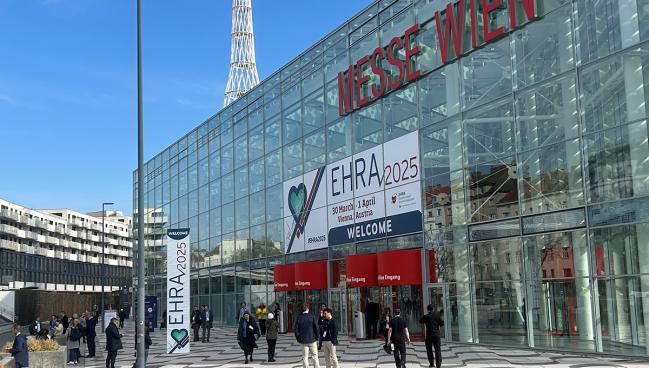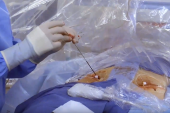Uncertainties Remain About Same-Day Discharge After AF Ablation
There are worries about delayed complications, but many places won’t get paid if AF patients don’t spend the night in hospital.

VIENNA, Austria—Although it may be safe to send patients home the same day after catheter ablation for atrial fibrillation (AF), there are still questions about what proportion of patients would be eligible and how they’d feel about it.
The likely advantages of more routine use of same-day discharge after pulmonary vein isolation (PVI) are patient comfort and cost savings, Nikola Pavlović, MD, PhD (University Hospital Dubrava, Zagreb, Croatia), said during a debate here at the European Heart Rhythm Association (EHRA) Congress 2025.
Resources at hospitals—including cath lab space and bed capacity—are constrained amid growing demand for AF ablation. While complications can occur after a patient leaves the hospital following ablation, same-day discharge “should be at least as safe as an overnight stay,” Pavlović said.
Arguing on the “con” side of the debate, David Duncker, MD (Hannover Heart Rhythm Center, Germany), focused on the still present—albeit low—risks following ablation, which would favor keeping patients in the hospital overnight after the procedure.
“We know that PVI safe and it is effective, of course, but we also face some complications,” he said.
In Favor of Same-Day Discharge
Arguing in favor of same-day discharge after PVI, Pavlović highlighted data demonstrating the feasibility of the approach. A systematic review and meta-analysis, for instance, showed that among patients who were planned for same-day discharge, the vast majority (90.3%) went home without an overnight stay. Pavlović noted, however, that across the studies included in the analysis, only 40.5% overall were discharged on the same day as the procedure.
There are nonrandomized studies indicating that it is safe to let patients go home the day of the procedure, he said. An EHRA meta-analysis published last year indicated similar safety and short-term outcomes when comparing same-day discharge with an overnight stay. Pavlović acknowledged that most of the included studies were retrospective and at significant risk of bias but pointed to additional data suggesting the safety of same-day discharge, with low rates of complications, visits to the emergency room, and rehospitalizations.
There are expected cost savings by discharging patients without an overnight stay, Pavlović pointed out, with the exact gains dependent on geography. He cited data showing that the average savings, for example, were £360 per patient in the United Kingdom and €859 per procedure in Spain. One US study indicated that for every 100 patients, if half were discharged on the same day as the ablation, the yearly money saved could be as high as $83,812.
In addition to the money, this approach would free up space for other admissions and optimize bed flow efficiency, Pavlović said.
Another important issue is how patients feel about same-day discharge. Pavlović highlighted an analysis of the FAST AFA study showing that among patients who had an overnight stay after AF ablation, half had a positive view of same-day discharge, identifying increased patient comfort, shorter waiting times, and cost-efficiency as possible benefits.
The issue, however, is that the patients’ concerns—uncertainties associated with complaints and delayed recognition of and response to complications—were not fully aligned with the concerns of electrophysiologists (EPs) identified on an EHRA survey. EPs are mostly worried complications, patient discomfort, and rehospitalizations.
Overall, Pavlović concluded, “same-day discharge is feasible in the majority of patients if you have a standard protocolized setup. It does not seem to raise the risk of complications and readmissions—although, caveat, most of the data are nonrandomized—and it does reduce the healthcare costs.”
There are still some questions about patient preference, the role of vascular closure devices, and the impact of new technologies, like pulsed-field ablation, he said, adding that there is a need for randomized trials to assess same-day discharge in this setting.
Complications Warrant Caution
Duncker spent much of his talk focused on the need for caution in the presence of the risk of potentially serious complications after ablation. There have been improvements over time, but one systematic review and pooled analysis showed that there was still a 3.8% rate of overall procedure-related complications and a 1.9% rate of serious complications, along with a low rate of mortality (0.05%), in the most recent period. “This is something we need to consider,” he said.
Another international registry study, for which Pavlović was a co-author, showed a 6.8% rate of cardiac tamponade and the occurrence of some strokes, cardiac arrests, esophageal fistulas, and death. Importantly, 20% of the tamponades observed occurred more than an hour after the procedure and 22% of affected patients presented with slow deterioration. The presumptive mechanism for the complication was known in only 46% of cases.
I’m very surprised . . . policymakers don’t incentivize same-day discharge because if they would, the next day we would all do it. Tobias Reichlin
“So if Nicola wants to select his patients to be sent home or not, he doesn’t know the mechanism for the tamponade in more than half of the patients,” Duncker said.
Even with pulsed-field ablation, which is touted to reduce complications like esophageal events, pulmonary vein stenosis, phrenic nerve palsy, and others compared with thermal ablation modalities, important complications like stroke, TIA, and death can still occur, as seen in the MANIFEST-17K study, Duncker said.
Although a consensus statement from EHRA and other groups states that a same-day discharge protocol is reasonable in selected patients undergoing AF ablation, it’s difficult to choose which patients will get sent home and which have a high enough risk to warrant an overnight stay, Duncker indicated. He cited the example of a patient who had ablation at his center and developed tamponade overnight. The patient lived 40 to 50 minutes away by car, and if the tamponade had occurred at home instead of in the hospital, the outcome might not have been as good, he suggested.
“This was easy to cover, but if I would’ve sent him back [home], I don’t think that I would have seen this patient back in our clinic,” said Duncker.
As for the feasibility of same-day discharge, Duncker pointed to a Canadian study showing that even when aiming for a same-day procedure for all patients, roughly one out of every five required an overnight stay.
Everyone is in agreement that PVI is safe and effective, Duncker said. But complications, though rare, can be severe, he added. “And same-day discharge introduces additional risk to our patient that would not be present in an inpatient PVI setting.”
Reimbursement and Other Challenges
A major challenge for implementing same-day discharge more widely is that there are financial disincentives to doing so in some places. In Croatia, for instance, “we don’t do it just because we are not reimbursed if it’s not an overnight stay. So we do it if we have limited bed capacity and we need to do it, but then the procedure is not paid by the government,” Pavlović explained.
Indeed, that’s the “elephant in the room,” Tobias Reichlin, MD (Inselspital – University Hospital Bern, Switzerland), said during a panel discussion. “We see in the geographies where reimbursement is favoring same-day discharge, it’s working quite well,” he said, citing the UK and Canada as examples. “I’m very surprised that in our geographies, the policymakers don’t incentivize same-day discharge because if they would, the next day we would all do it.”
That wouldn’t be for all patients undergoing AF ablation, he clarified, estimating that about 80% of PVI cases could be done with same-day discharge and 20% would require the patient to stay in the hospital overnight.
Pavlović stressed that implementation of same-day discharge after AF ablation would require a standardized protocol to ensure that only those patients who can safely go home early are allowed to do so.
However, Isabel Deisenhofer, MD (German Heart Centre Munich, Germany), one of the chairs of the debate session, suggested that many patients undergoing AF ablation—who are often 70 years or older—would feel more comfortable staying overnight in case there are complications.
A selective approach to same-day discharge could have different workflows for AF ablation—one for patients who are going home early and one for those who need to stay in the hospital—but that might cause problems, too. “That’s always something that creates confusion, that can create mistakes, that can create mistreatment,” she said. “I’m not sure that anybody wants that.”
For now, it seems most EPs—at least in Europe—are opting for an overnight stay for their PVI cases: the EHRA survey showed that only 16% to 20% of such procedures were being done with same-day discharge.
Todd Neale is the Associate News Editor for TCTMD and a Senior Medical Journalist. He got his start in journalism at …
Read Full BioSources
Multiple presentations. Presented at: EHRA 2025. March 30, 2025. Vienna, Austria.
Disclosures
- Pavlović reports consulting/proctoring fees or honoraria from Abbott, Biosense Webster, Edwards Lifesciences, Medtronic, and P&F Products & Features; research grants from Medtronic; and educational grants from EHRA and the European Society of Cardiology.
- Duncker reports speaking honoraria from Abbott, AstraZeneca, Biotronik, Boehringer Ingelheim, Boston Scientific, Bristol Myers Squibb, CVRx, Medtronic, Microport, Pfizer, Sanofi, and Zoll.





Comments